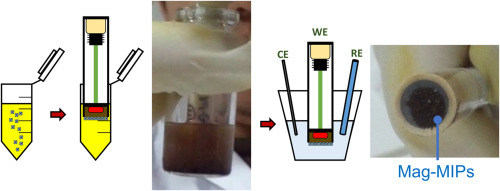Talanta ( IF 5.6 ) Pub Date : 2017-12-28 , DOI: 10.1016/j.talanta.2017.12.085 Gerson A. Ruiz-Córdova , Sabir Khan , Luís Moreira Gonçalves , Maria Isabel Pividori , Gino Picasso , Maria Del Pilar T. Sotomayor

|
The determination of 1-chloro-2,4-dinitrobenzene (CDNB) was used as a proof-of-concept to a simple analytical practical configuration applying magnetic molecularly imprinted particles (mag-MIPs). Mag-MIPs were captured from an emulsion by a home-made magneto-sensor (where a small magnet was entrapped by a graphite-epoxy composite) and then, this sensor, was transferred to the solution containing the analyte, where, after binding to the mag-MIPs, the analyte was directly analysed using differential pulse voltammetry (DPV) since the magneto-sensor acted as the working electrode. After optimization, a detection limit of 6.0 μmol L−1 with a RSD of 2.7% was achieved along with suitable recoveries and selectivity. This methodology offers a different approach for electroanalytical methodologies using mag-MIPs.
中文翻译:

使用先前由磁传感器捕获的磁性分子印迹聚合物颗粒进行电化学感测
1-氯-2,4-二硝基苯(CDNB)的测定用作应用磁性分子印迹粒子(mag-MIPs)的简单分析实用配置的概念验证。通过自制的磁传感器(其中的小磁体被石墨-环氧复合材料包裹)从乳液中捕获了Mag-MIP,然后将该传感器转移到含有分析物的溶液中,然后与在mag-MIPs中,由于磁传感器充当工作电极,因此使用差分脉冲伏安法(DPV)直接分析了分析物。优化后,达到了6.0μmolL -1的检出限,相对标准偏差为2.7%,同时具有适当的回收率和选择性。该方法为使用mag-MIP的电分析方法提供了另一种方法。











































 京公网安备 11010802027423号
京公网安备 11010802027423号